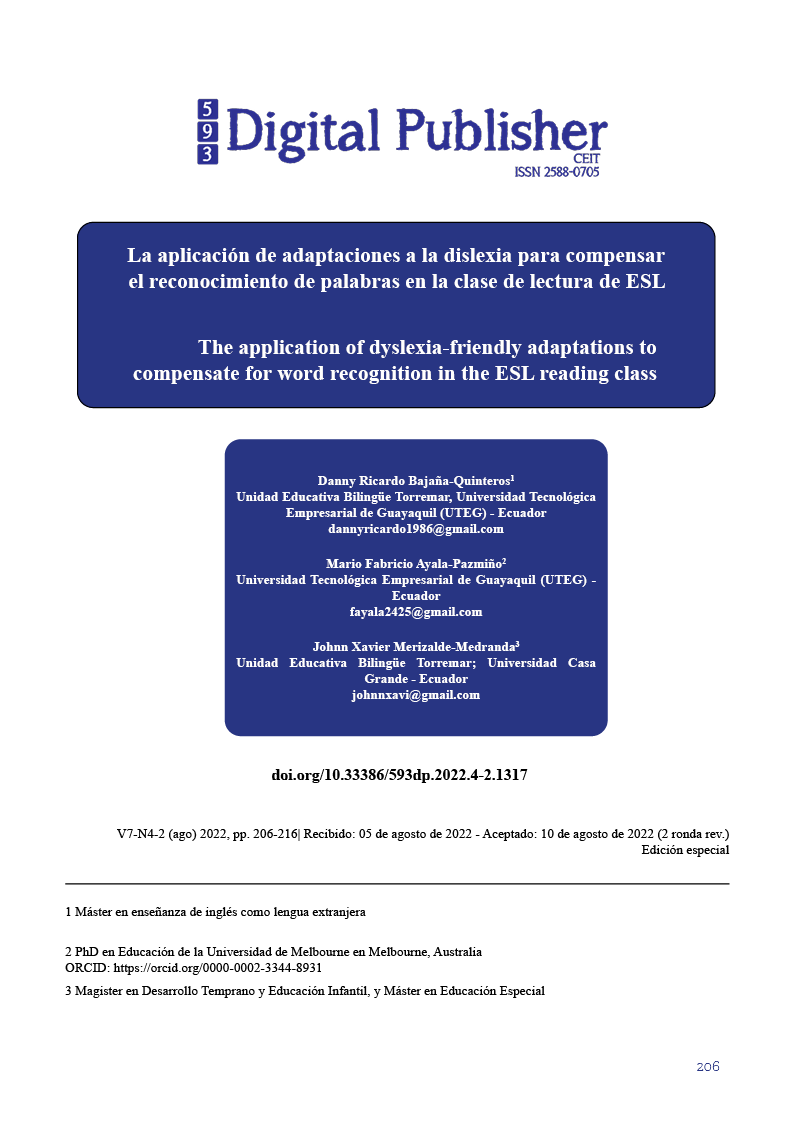The application of dyslexia-friendly adaptations to compensate for word recognition in the ESL reading class
Main Article Content
Abstract
Dyslexia students face many difficulties in their learning environment and daily life. They need to compensate for their learning disabilities and be able to deal with the low esteem that is left from becoming aware that they cannot progress at the same speed as their partners. This study suggests using dyslexia-friendly adaptations in ESL texts to compensate for one fundamental thinking process, word recognition, which conforms to all functions developed while reading. By supporting single-word decoding and phonological awareness, dyslexia students take the first step to working with words' meanings. The study finds its relevance for EFL teaching, and learning since learning difficulties affect English Language acquisition, and additionally because of the difficulties that the English language already includes.
Downloads
Article Details

This work is licensed under a Creative Commons Attribution-NonCommercial-ShareAlike 4.0 International License.
1. Derechos de autor
Las obras que se publican en 593 Digital Publisher CEIT están sujetas a los siguientes términos:
1.1. 593 Digital Publisher CEIT, conserva los derechos patrimoniales (copyright) de las obras publicadas, favorece y permite la reutilización de las mismas bajo la licencia Licencia Creative Commons 4.0 de Reconocimiento-NoComercial-CompartirIgual 4.0, por lo cual se pueden copiar, usar, difundir, transmitir y exponer públicamente, siempre que:
1.1.a. Se cite la autoría y fuente original de su publicación (revista, editorial, URL).
1.1.b. No se usen para fines comerciales u onerosos.
1.1.c. Se mencione la existencia y especificaciones de esta licencia de uso.
References
Dewaele, J.-M., Witney, J., Saito, K., & Dewaele, L. (2017). Foreign language enjoyment and anxiety: The effect of teacher and learner variables. Language Teaching Research, 22(6), 676–697. https://doi.org/10.1177/1362168817692161
Educación, M. de. (2019). MINISTERIO DE EDUACIóN DEL ECUADOR Informe preliminar Rendición de Cuentas 2019.
Friesen, D. C., & Haigh, C. A. (2018). How and Why Strategy Instruction Can Improve Second Language Reading Comprehension: A Review. In The reading matrix (Vol. 18, Issue 1, p. 1). Reading Matrix, Inc . http://unir.summon.serialssolutions.com/2.0.0/link/0/eLvHCXMwtV1LS8NAEF5aPVQQ8f2WPXkplSS7STaChyBq8XEQq_UglDy2tEKDtBXsv3cmu9nEF-jBSwhbOoH9JpNvZ7-ZJYQ5R1brU0xgjoj9IAZv7nss9axYMKsvU5lwJ7LsyM2rpYOHK-_8wrmt1YquEOXYvwIPYwA9FtL-AXxjFAbgHlwAruAEcP2VG-CRcZgb7w5mTd
Grabe, W. (2004). 3. RESEARCH ON TEACHING READING. Annual Review of Applied Linguistics, 24, 44–69. https://doi.org/http://dx.doi.org/10.1017/S0267190504000030
How Spelling Supports Reading | LD Topics | LD OnLine. (n.d.). Retrieved June 28, 2021, from http://www.ldonline.org/article/How_Spelling_Supports_Reading
Lyon, G., Fletcher, J., Shaywitz, S., Shaywitz, B., Torgesen, J., Wood, F., Schulte, A., & Olson, R. (2001). Rethinking Learning Disabilities.
Lyon, G. R., Shaywitz, S. E., & Shaywitz, B. A. (2003). Defining Dyslexia, Comorbidity, Teachers' Knowledge of Language and Reading A Definition of Dyslexia. Annals of Dyslexia, 53, 1–14. http://www.espaciotv.es:2048/referer/secretcode/scholarly-journals/defining-dyslexia-comorbidity-teachers-knowledge/docview/225373075/se-2?accountid=142712
Marín-Ospina, M. D., Reyes-Franco, J. A., & Castañeda-Ibáñez, N. N. (2019). Dislexia y bilingüismo: estudios de caso en población infantil* Dyslexia and bilingualism: Case reports in children. Diversitas, 15(2), 187–199.
Montero-Arévalo, S. J. (2019). Effects Of Genre Based Approach (GBA) In EFL Reading Comprehension And Writing. GIST – Education and Learning Research Journal, 19, 84–100. https://doi.org/10.26817/16925777.762
Pennington, B. F. (2006). From Single to Multiple Deficit Models of Developmental Disorders. In Cognition (Vol. 101, Issue 2, p. 385). Elsevier. https://doi.org/10.1016/j.cognition.2006.04.008
Reiter, A., Tucha, O., & Lange, K. W. (2005). Executive functions in children with dyslexia. Dyslexia, 11(2), 116–131.
Seeff-Gabriel, B. (2003). Phonological processing: a platform for assisting second-language learners with English spelling. Child Language Teaching and Therapy, 19(3), 291–310. https://doi.org/http://dx.doi.org/10.1191/0265659003ct256oa
Tacuri, R. D., Bernal, M., & Buñay, R. (2018). La relación del logro de la lectura con la lateralidad, el movimiento ocular sacádico y el color en los niños. Maskana, 9(1), 13–19.
Tunmer, W., & Greaney, K. (2010). Defining Dyslexia. Journal of Learning Disabilities, 43(3), 229–243. https://doi.org/http://dx.doi.org/10.1177/0022219409345009




